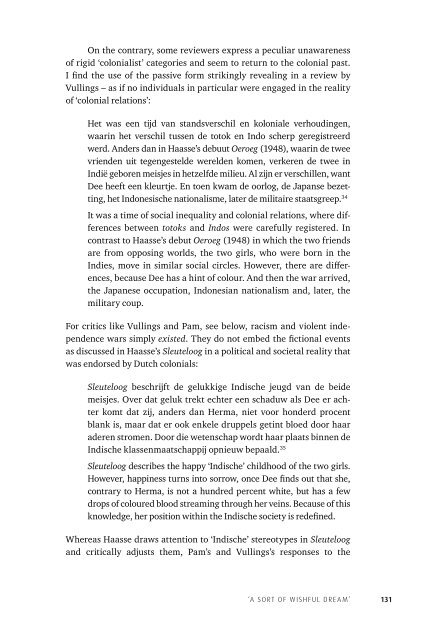Discord Consensus
7aze300jFJo
7aze300jFJo
You also want an ePaper? Increase the reach of your titles
YUMPU automatically turns print PDFs into web optimized ePapers that Google loves.
On the contrary, some reviewers express a peculiar unawareness<br />
of rigid ‘colonialist’ categories and seem to return to the colonial past.<br />
I find the use of the passive form strikingly revealing in a review by<br />
Vullings –as if no individuals in particular were engaged in the reality<br />
of ‘colonial relations’:<br />
Het was een tijd van standsverschil en koloniale verhoudingen,<br />
waarin het verschil tussen de totok en Indo scherp geregistreerd<br />
werd. Anders dan in Haasse’s debuut Oeroeg (1948), waarin de twee<br />
vrienden uit tegengestelde werelden komen, verkeren de twee in<br />
Indië geboren meisjes in hetzelfde milieu. Al zijn er verschillen, want<br />
Dee heeft een kleurtje. En toen kwam de oorlog, de Japanse bezetting,<br />
het Indonesische nationalisme, later de militaire staatsgreep. 34<br />
It was a time of social inequality and colonial relations, where differences<br />
between totoks and Indos were carefully registered. In<br />
contrast to Haasse’s debut Oeroeg (1948) in which the two friends<br />
are from opposing worlds, the two girls, who were born in the<br />
Indies, move in similar social circles. However, there are differences,<br />
because Dee has a hint of colour. And then the war arrived,<br />
the Japanese occupation, Indonesian nationalism and, later, the<br />
military coup.<br />
For critics like Vullings and Pam, see below, racism and violent independence<br />
wars simply existed. They do not embed the fictional events<br />
as discussed in Haasse’s Sleuteloog in a political and societal reality that<br />
was endorsed by Dutch colonials:<br />
Sleuteloog beschrijft de gelukkige Indische jeugd van de beide<br />
meisjes. Over dat geluk trekt echter een schaduw als Dee er achter<br />
komt dat zij, anders dan Herma, niet voor honderd procent<br />
blank is, maar dat er ook enkele druppels getint bloed door haar<br />
aderen stromen. Door die wetenschap wordt haar plaats binnen de<br />
Indische klassenmaatschappij opnieuw bepaald. 35<br />
Sleuteloog describes the happy ‘Indische’ childhood of the two girls.<br />
However, happiness turns into sorrow, once Dee finds out that she,<br />
contrary to Herma, is not a hundred percent white, but has a few<br />
drops of coloured blood streaming through her veins. Because of this<br />
knowledge, her position within the Indische society is redefined.<br />
Whereas Haasse draws attention to ‘Indische’ stereotypes in Sleuteloog<br />
and critically adjusts them, Pam’s and Vullings’s responses to the<br />
‘A sort of wishful dream’ 131


